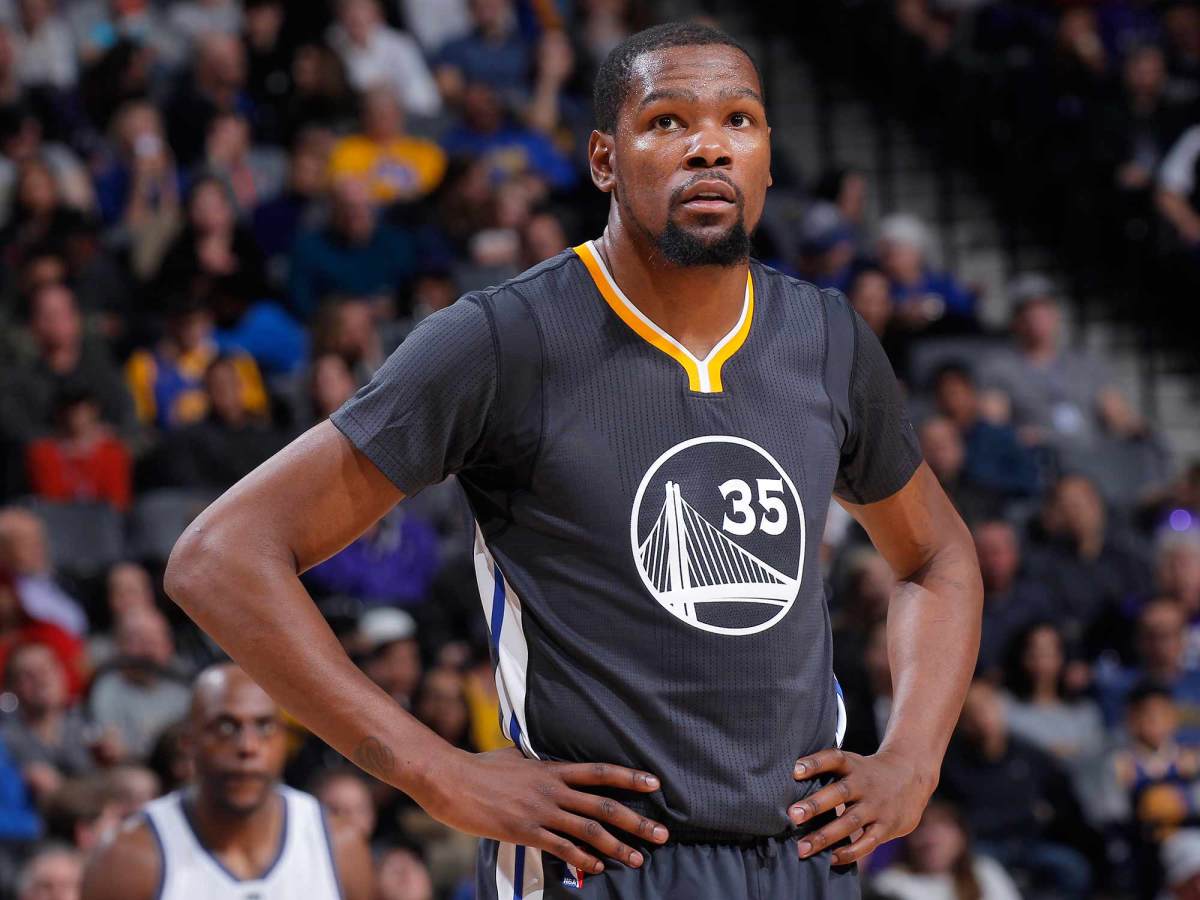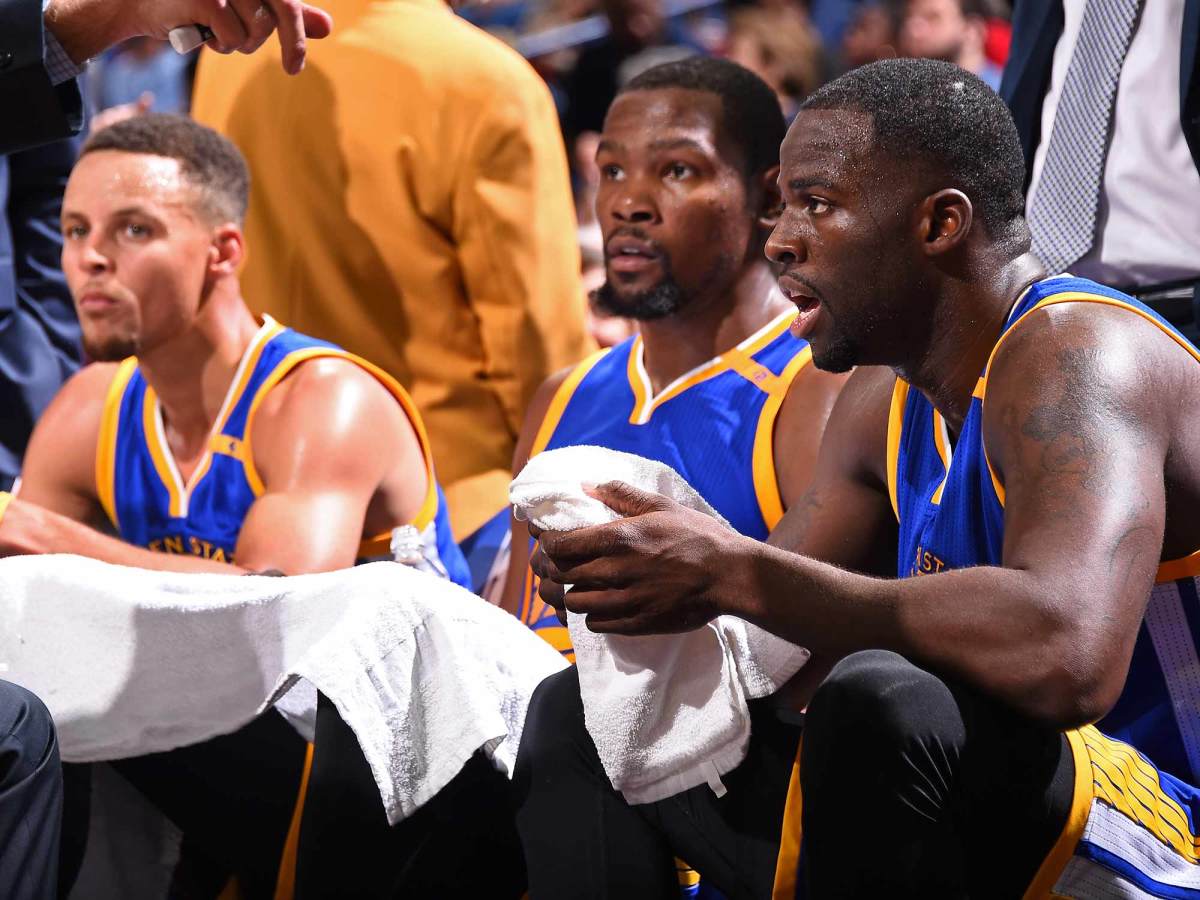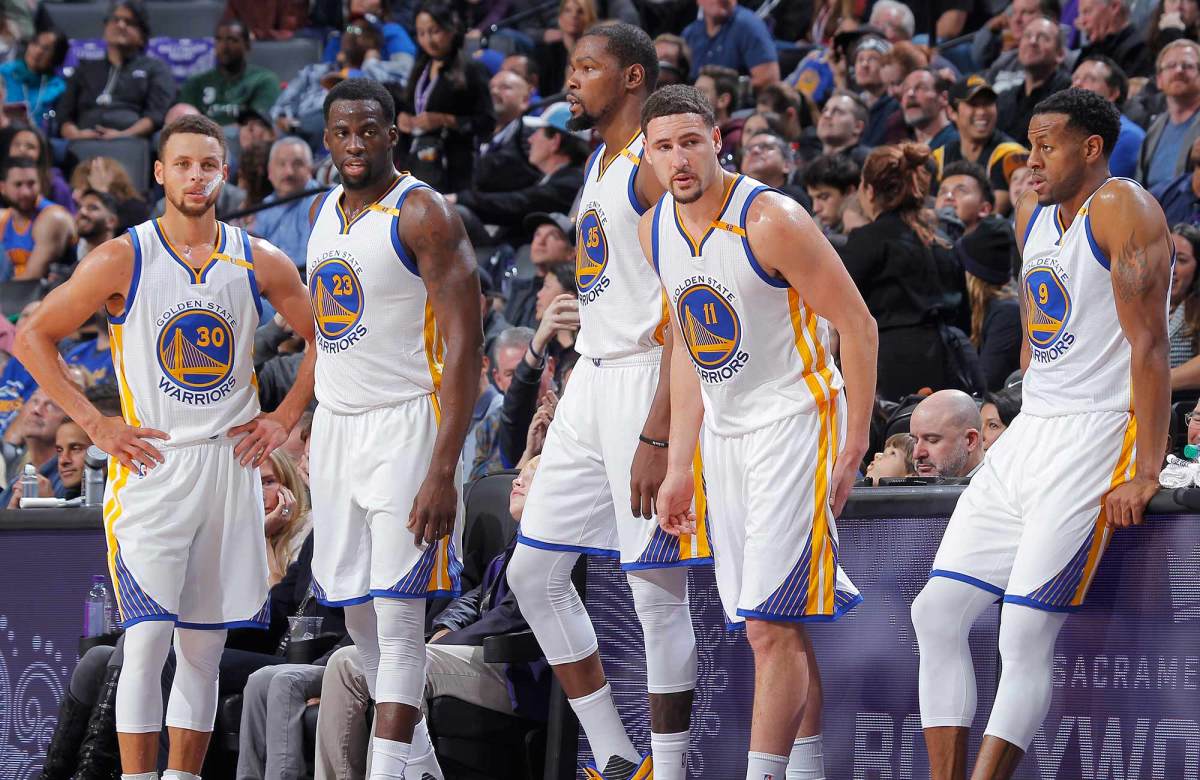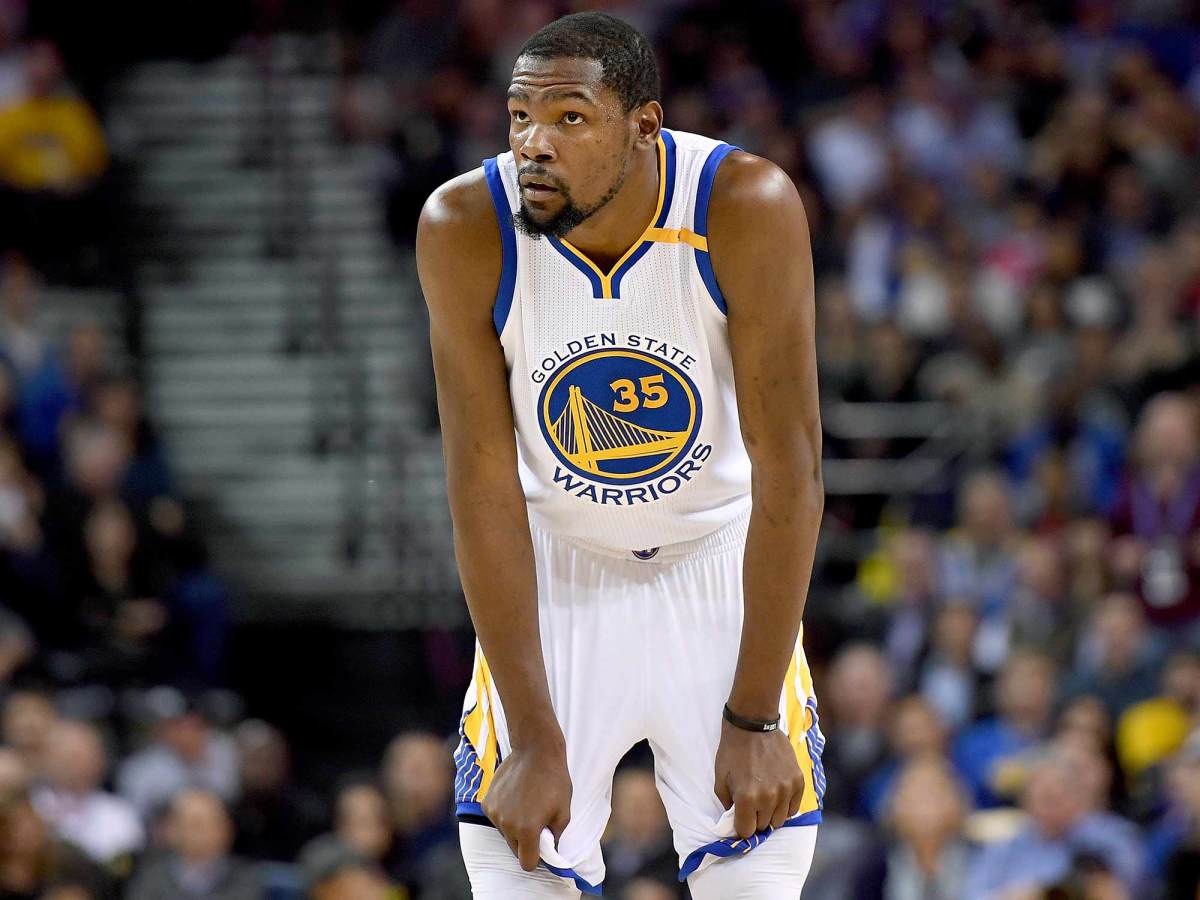The Six Biggest Ripple Effects Of Kevin Durant's Injury

Thanks to one awkward, misplaced fall by ZazaPachulia, the NBA’s most care-free team found itself sweating out an MRI result that had the potential to derail their title hopes.
The news wound up feeling like a reprieve rather than a death sentence: Kevin Durant will miss at least one month after suffering a Grade 2 MCL sprain and a tibial bone bruise in his left knee when Pachulia accidentally fell on him during Golden State’s road loss to Washington on Tuesday. That timetable sets up a possible regular-season return for Durant—given that there are six weeks remaining before the playoffs—and qualifies as positive news for his postseason outlook. Still, there is no firm recovery date, which forces Golden State to enter March scrambling after spending the previous four months on cruise control.
Indeed, the Warriors enter Wednesday’s action ranking first in winning percentage, point differential and offensive efficiency. They “only” rank second in defensive efficiency. They're on track for home-court advantage throughout the postseason, they landed four All-Stars on the West team, and that foursome had missed a combined seven games, enjoying near perfect health and logging fewer than 35 minutes per night each. Their biggest roster debate, before Durant’s injury, was whether to cut Briante Weber, a promising D-League call-up, in favor of veteran Jose Calderon to handle bit minutes en route to an inevitable third straight Finals showdown with the Cavaliers.
Kevin Durant's Injury Removes Warriors' Safety Net
That dependable success and nightly talent advantage generated a self-assurance that has displayed itself recently in gags, boasts and feats of splendor. Stephen Curry planked during the All-Star Game, Draymond Green openly ripped Paul Pierce in a trash-talking session, and Kevin Durant stuck up for JaVale McGee by poking holes in Shaquille O’Neal’s Hall of Fame resume. Pressed by the Clippers in the first half of a game late last week, the Warriors responded with a 50-point third-quarter, a clear reminder to their Pacific Division rivals and the rest of the league of just how potent they can be when they crank it up.
But Durant’s injury and his tricky timetable forces the Warriors to return to injury management mode. Just as their 2016 postseason run was defined by Stephen Curry’s health and limitations, the Warriors’ next three months will hinge on Durant’s ability to return to the court, and then, to form. In the meantime, let’s run down the major implications of Durant’s diagnosis.

1. The Warriors are no longer clear-cut title favorites
Make no mistake, the 2017 title was the Warriors’ to lose prior to Tuesday night’s unfortunate turn of events. While one-sided regular-season results were expected as soon as Durant agreed to sign on July 4, the new-look Warriors have fully delivered on the Superteam hype. Through 60 games, the Warriors have the fourth-best point differential of all time and are on track for 68 wins.
Despite serious roster turnover last summer, their point differential this season has been better than in either of the past two years, in large part because Durant’s transition has been seamless. Per NBA.com, Durant has posted an outrageous +15.2 net rating this season, the Warriors’ preferred “big” starting lineup has boasted a ridiculous +23.1 net rating (far better than last year’s starters), and their most-used small–ball lineup has been rock solid (+23.9).
When Durant has been off the court this season, Golden State’s net rating slips to +6.6. That’s still a strong mark—similar to the 2017 Rockets and the 2016 Thunder—but not a world-beating one. Durant’s impact is particularly felt on the offensive end, as Golden State’s offensive efficiency drops by more than 9.5 points when he leaves the court. With Durant, the Warriors are the league’s most efficient offense. When he’s off the court, they slip to roughly No. 10, right around the likes of Minnesota and Milwaukee. That’s still good enough to win a title when coupled with an elite defense, but no longer so extraordinary that they should be viewed as presumptive favorites until Durant proves he’s back and healthy.
While Golden State’s defensive efficiency has been roughly the same with and without Durant this season, his absence will definitely show on that end too. Last year, the Warriors grinded out postseason wins as they waited for Curry to return from a knee injury. That will be tougher this year due to the offseason loss of three players—Harrison Barnes, Andrew Bogut and Festus Ezeli—who departed to make way for Durant. Without Durant and Barnes, Golden State will find it much more difficult to play elite defense and protect the defensive glass when it goes to smaller lineups.
2. The Warriors’ No. 1 seed is in jeopardy
Rushing to analyze how Durant’s return from injury might tilt a Finals matchup with LeBron James and the Cavaliers would be a mistake. The Warriors will have their hands full getting out of a Western Conference full of second-tier contenders that have been given new life by this news.
The New Normal: Isaiah Thomas Explains How We Got Here
That pack starts with the Spurs, who are just three games behind the Warriors in the loss column and will play host to Golden State twice in March. Although the Warriors remain in the driver’s seat, their grip on the No. 1 seed and a first-round cakewalk against a sub-.500 team is no longer guaranteed. Slipping out of the top seed would make for a much tougher path to the Finals. In their current best-case scenario, they’d feast on the Nuggets/Kings/Blazers/Mavericks in round one and get the Jazz or Clippers in round two before theoretically taking on the winner of Spurs/Rockets in the West finals. In a worst-case scenario, the No. 2 Warriors would have to go through the Thunder, Rockets and Spurs to get to the Finals. That best-case sounds very doable, even if Durant’s absence keeps him sidelined for two months. The worst-case sounds like a gauntlet that would require Durant’s return as soon as possible.
It should be noted that facing San Antonio, owners of the league’s second-best point differential, is suddenly a pretty scary proposition for Golden State. Durant’s versatility was key to forcing San Antonio into smaller lineups and his ability to match-up with Kawhi Leonard set up Golden State’s other star talent to win their respective matchups. Now, the Warriors are left scrambling to deal with Leonard and to decide how often they are willing to stay big against the likes of LaMarcus Aldridge and Pau Gasol. Throw in the Spurs’ ever-present balance, discipline, experience and ability to dictate pace, and this is exactly the type of opponent capable of exploiting the Warriors’ newfound uncertainty in a playoff series.

3. The Warriors now have major (and multiple) positional holes
Like the true superstar that he is, Durant brings value to the Warriors in all sorts of ways, leading his team in points, rebounds and blocks. He scores in one-on-one scenarios, he spaces the court and knocks down catch-and-shoot threes, he hits the open man, he gets out in transition, he gets to the free-throw line, he defends multiple positions, he plays all three frontcourt positions at times, he steps out and switches defensively, and he protects the rim. Golden State’s reliance on him is clear: Only four Warriors lineups have logged at least 100 minutes together this season, and Durant is a member of all four.
In each of the Warriors’ major potential matchups, Durant represents the ace up their sleeve. The Clippers can only muster a one-way stopper, Luc Richard Mbah a Moute, at his spot, and L.A.'s 4-on-5 approach has left them often looking completely overwhelmed against Golden State. As good as Houston’s Harden-centric approach has been this season, any coach would prefer the luxury of an offense driven by multiple superstars like Durant and Curry. Against San Antonio, the Durant/Draymond Green frontline combination promises to force Gregg Popovich to downsize his lineups and play on Golden State’s terms more often. And, of course, Durant’s ability to push James in a way that Harrison Barnes couldn’t have seemed to be Golden State’s best chance for unseating Cleveland.
The Beard: James Harden Untangles His Life And Game
Unfortunately for the Warriors, adding Durant required parting with multiple pieces who, especially if healthy, would be useful in his absence. Golden State no longer has Barnes in its arsenal of physical players to throw at Leonard and James and it no longer has Andrew Bogut and Festus Ezeli to play the role of rim-protector in big lineups. Instead, coach Steve Kerr is forced to pick from less-than-perfect options to fill in for Durant at the three spot: he can lean more heavily on sixth man Andre Iguodala, he can trust rookie Patrick McCaw, and he can hope that the 36-year-old Matt Barnes, an emergency signing after he was cut last week by Sacramento, is able to fill minutes as a hard-nosed stand-in.
Even if those guys can help Golden State get by on offense, playing complementary roles to Curry and Klay Thompson, Kerr will still need to replace Durant’s contributions on the other end. Green is a proven difference-maker at both the four and five, but he will need help. Iguodala, McCaw and Barnes simply can’t match Durant’s length and interior defense, forcing Kerr to play traditional lineups with centers more often, strike a middle ground with veteran power forward David West, or run the risk that his smaller lineups get exploited at the rim or on the glass.
The takeaway should be clear: To compete with Cleveland and San Antonio, Golden State needs to be able to fully count on Durant.

4. The Warriors can’t turn to past lineup combinations for help
This might seem obvious to careful observers, but the Warriors can’t simply “Go back to what they were doing before they got Durant” because so many faces have changed since last year. Yes, Curry and Thompson can step forward offensively, allowing the small forward to play more of a complementary, stand-in-the-corner role. However, Kerr can’t just hit the rewind button, as the Warriors’ 13 (!) most-used lineups from last year all include at least one player (Bogut, Harrison Barnes, Ezeli, Leandro Barbosa, Mo Speights) who is no longer with the team.
Continuity was set to be one of Golden State’s major advantages in a Finals matchup against Cleveland. The Warriors’ starters have logged nearly twice as many minutes together as the Cavaliers’ starters—thanks to injuries to J.R. Smith and Kevin Love—even though Kerr heavily staggers his stars. Now, Golden State will likely pray that Matt Barnes can keep things afloat early in games, allowing Iguodala and the rest of the Warriors’ second-unit players to keep consistent roles. With Smith and Love projected to return in time to get some real reps together before the postseason, Golden State has ceded “steady ship” status to Cleveland.
5. Durant’s MVP push is over and his All-NBA status is up for debate
While two of his former Thunder teammates, James Harden and Russell Westbrook, have dominated the MVP talk this season, Durant wasn’t going to go down without a fight. His case was simple: he’s been the best player on the best team, he’s been a better two-way player than both Harden and Westbrook, he’s posted monster numbers (25.8 PPG, 8.4 RPG, 4.9 APG, 1.7 BPG, 1.1 SPG) and he’s boasted excellent advanced stats (No. 3 in PER, No. 2 in Win Shares, No. 7 in Real Plus Minus). Now, that all goes out the window given that he’ll likely miss the final quarter of the season.
Durant also looked like he was going to return the All-NBA First Team after getting bumped to the Second Team last year and missing out altogether in 2015 due to foot injuries. Instead, James and Leonard will likely capture the First Team slots. It’s somewhat possible, considering the depth of the candidate pool, that Durant’s stellar play winds up going entirely unrecognized due to the injury. Giannis Antetokounmpo, Anthony Davis, Jimmy Butler, Gordon Hayward, Paul Millsap, Paul George and Kevin Love could all draw votes at the forward spots, forcing voters to decide whether 59 games from Durant (if he doesn't return before the playoffs) tops 70+ games from some of those other candidates. Recent injury precedents, like Sacramento’s DeMarcus Cousins last year, suggest that Durant should at least be able to sneak onto the Third Team.

6. Kevin Durant might have been saved from some truly harrowing legacy talk
The basketball world should be breathing one giant sigh of relief for Durant’s health and a second one for the legacy discussions that hopefully will be circumvented if he returns to the court to be a postseason difference-maker.
Remember, Durant’s ideal scenario this season was finally toppling James, getting redemption for the Thunder’s 2016 playoff meltdown, winning his first title, and staking his claim to the “Best Player in the World” title, thereby fully validating his decision to leave Oklahoma City for Golden State. Had he been lost for the year, he would have been set up for a brutal “Damned if the Warriors do, damned if they don’t” fork in the road.
Let’s think this through. If Golden State had managed to win the title after Durant suffered a season-ending injury, his critics would have all the ammunition they need to continue arguing that he was a front-running hired gun. On the other hand, though, Durant’s injury would have become the defining moment of the Warriors’ season if they don’t win the title (and it still might be). In that scenario, his health would have become another annoying asterisk, residing alongside Draymond Green’s suspension during the 2016 Finals.
Instead of being in position to answer every question that has accumulated over the last decade and to counter every critic who mocked his off–season move, an injured Durant would have faced two paths: one taking him to bittersweet, unsatisfying success if the Warriors won without him and the other leading to hopeless distress if he cost his team a title shot.
It’s truly unsettling to think about how close Durant came to a legacy disaster area. With any luck, he will return on schedule so that the NBA’s emerging postseason storylines can pick up where they left off.
